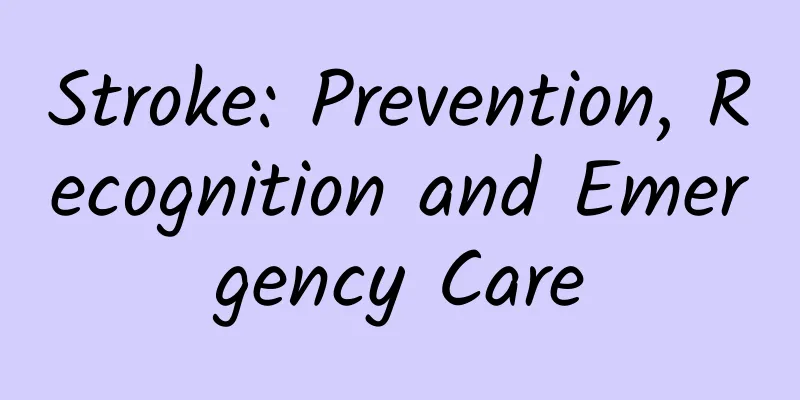Stroke: Prevention, Recognition and Emergency Care

|
Stroke, commonly known as "stroke", is an acute cerebrovascular disease that causes brain tissue damage due to sudden rupture of brain blood vessels or blood vessel blockage that prevents blood from flowing into the brain. Stroke has the characteristics of high morbidity, high mortality and high disability rate, which seriously threatens people's life and health. Therefore, it is very important to understand the knowledge of prevention, identification and emergency care of stroke. How much do you know about stroke? 1. Types of stroke Stroke is mainly divided into two categories: ischemic stroke and hemorrhagic stroke. Ischemic stroke is caused by blood vessel blockage, resulting in cerebral ischemia and hypoxia; while hemorrhagic stroke is caused by rupture of brain blood vessels, causing blood to enter the brain tissue. 2. Symptoms of stroke The symptoms of stroke vary from person to person, but usually manifest as sudden headache, vomiting, impaired consciousness, slurred speech, limb weakness or numbness, etc. If these symptoms occur, you should seek medical attention immediately. 3. Risk factors for stroke High-risk factors for stroke include high blood pressure, diabetes, high blood lipids, heart disease, smoking, alcoholism, obesity, lack of exercise, etc. Controlling these high-risk factors can help reduce the risk of stroke. Preventing stroke starts from daily life 1. Eat a healthy diet Maintaining a low-salt, low-fat, low-sugar diet and increasing the intake of vegetables, fruits, and whole grains can help lower blood pressure, blood lipids, and blood sugar, thereby preventing stroke. 2. Exercise moderately Regularly performing moderate aerobic exercise, such as walking, jogging, swimming, etc., can enhance cardiopulmonary function, promote blood circulation, and reduce the risk of stroke. 3. Quit smoking and limit alcohol consumption Smoking and excessive drinking both increase the risk of stroke. Quitting smoking and limiting alcohol consumption can help protect blood vessel health and prevent stroke. 4. Control your weight Obesity is one of the high-risk factors for stroke. Keeping your weight within a normal range through a proper diet and moderate exercise can help reduce the risk of stroke. 5. Regular medical check-ups Regular physical examinations and timely detection and control of chronic diseases such as hypertension, diabetes, and hyperlipidemia can help prevent stroke. Identify stroke and seize the golden rescue time 1. Rapidly identify stroke Mastering the "FAST" principle will help you quickly identify a stroke: F (Face) facial asymmetry; A (Arm) arm weakness; S (Speech) slurred speech; T (Time) time is life. Once you find these symptoms, call the emergency number immediately. 2. Stay calm and respond appropriately While waiting for emergency personnel to arrive, stay calm and lay the patient flat on the ground to avoid injuries to the head, neck and back. If the patient vomits, turn his head to one side to prevent vomitus from blocking the airway. Emergency care, fighting for life 1. Keep the airway open During the first aid process, ensure that the patient's airway is open. If the patient is unconscious, he should lie on his side or tilt his head to one side to prevent vomit or secretions from blocking the airway. 2. Monitor vital signs Closely observe changes in the patient's consciousness, pupils, breathing, heart rate and other vital signs. If any abnormality is found, notify the doctor in time for treatment. 3. Establishing intravenous access During emergency treatment, it may be necessary to establish an intravenous access for the patient so that medication can be given in a timely manner, which requires medical staff to have skilled operation skills. 4. Cooperate with doctors for treatment During the emergency treatment process, family members should actively cooperate with the doctor's treatment plan, such as signing an informed consent form, providing the patient's medical history, etc. This will help the doctor to more accurately judge the condition and formulate an appropriate treatment plan. 5. Psychological support and comfort Stroke patients and their families may experience negative emotions such as anxiety and fear during emergency treatment. Medical staff should provide psychological support and comfort to help them overcome difficulties. Rehabilitation care helps patients regain confidence in life 1. Rehabilitation exercises During the rehabilitation period, patients should undergo rehabilitation exercises under the guidance of professional rehabilitation therapists, including limb function training, speech training, cognitive training, etc. This will help patients regain their ability to take care of themselves. 2. Reasonable diet and nutritional support Patients in the recovery period should maintain a healthy diet and take in enough nutrition to support physical recovery. Family members can develop a personalized diet plan based on the patient's actual situation. 3. Regular follow-up and review Patients in the recovery period should go to the hospital regularly for follow-up and reexamination so that doctors can understand their recovery status in a timely manner and adjust treatment plans. 4. Psychological adjustment and social support Stroke patients may face psychological adjustment problems during the recovery period. Family members and society should give them care and support to help them regain confidence in life. Summary and Outlook Stroke is a serious cerebrovascular disease. Prevention, identification and emergency care are of great significance in reducing its morbidity and mortality. Through the introduction of this article, I hope everyone can have a deeper understanding of the relevant knowledge of stroke and protect the health of themselves and their families. With the continuous advancement of medical technology and people's increasing attention to healthy living, I believe that the prevention, identification and emergency care of stroke will be more perfect in the future. Let us work together to contribute to defeating stroke, the health killer! Author: Cai Ying Dingxing County Hospital |
<<: There's a vaccine for acne! But don't get too excited.
>>: Daily care and self-management of patients with diabetes
Recommend
I haven't had sex for 2 months but I'm pregnant
I believe that although most female friends have ...
What to do if pregnant women sometimes have difficulty breathing
After pregnancy, many women's bodies show abn...
Bad habits cause premature aging of the cervical spine. Symptoms and prevention of cervical spondylosis. How to prevent chronic cervical injury?
Due to long-term chronic strain, the age of onset...
Can I have sex on the first day after my period?
It is not suitable to have sex during menstruatio...
What should I do if I have sex 10 days after IUD removal?
Nowadays, there are more and more ways to prevent...
What should I do if the neutrophil percentage in pregnant women is high?
A high percentage of neutrophils in pregnant wome...
Medicine for treating leucorrhea
Abnormal leucorrhea is a problem that exists in m...
What to do if the ovarian corpus luteum is insufficient
The state of the ovaries is very important for wo...
Why does menstruation come once every few months?
We all know that the normal menstrual cycle shoul...
What are some ways to make your breasts bigger?
In modern society, there are more and more women ...
What to do if ovarian atrophy
The ovaries are a relatively important part of a ...
A woman dreamed of losing a small piece of her tooth.
Tooth loss is very common in daily life, but losi...
How to relieve dysmenorrhea?
I believe every woman has experienced dysmenorrhe...
Insider Intelligence: Twitter is expected to lose 30 million users in two years
Recently, according to foreign media reports, a r...
Why does it take so long to recover from an ankle sprain? How to deal with an ankle sprain in an emergency
Ankle sprains are commonly known as sprains. Spra...









